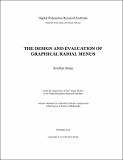| dc.description.abstract | Graphical menus provide slow performance and yet users often try to select menu commands as fast as possible. Shortcut techniques that enable users to by-pass selections from a graphical menu are fast, but are not the ultimate answer to the performance problem. Shortcut techniques pose high demands on human memory. They require much training and frequent use. They do not scale well. And they often cannot be provided on devices with limited capabilities, such as mobile devices with small screens, small keyboards, or touch screens. Because of these problems, users often times 'stick' to a graphical menu and are condemned to its poor performance. This thesis argues that the performance of graphical menus can be improved. The thesis consists of three parts: The first part presents the background knowledge and the problem of slow graphical menus. The second part presents the design of a menu that supports the needs of novices, experts, and those transitioning from novice to expert. In particular, the design explicitly aims at improving selection performance by leveraging concentric radial layout. The third part of the thesis presents the evaluation of the design and its main characteristics. Four studies are conducted based on two controlled, user experiments. A number of variables are analysed including pointing time, visual search time, navigation performance, novice/expert performance, navigation errors, and screen consumption. A number of factors are controlled including menu size, location of menu items, menu design, and layout variation. Traditional linear menus are included for comparison. Objective and subjective measures are used. Additionally, a performance model based on pointing laws is proposed and used to measure the motor processing rates of tested designs. The evaluation shows that designing with performance in mind can result in faster graphical menus compared to traditional menus. The proposed Compact Radial Layout menu is approximately 20-30% faster in a variety of conditions, reduces navigation errors, induces users to faster movements and decreases screen consumption. The evaluation also shows that, with a consistent pattern of organizing items in radial menus, search and navigation performance can be further improved. At the same time, the results indicate that the improved navigation performance in radial menus comes at the cost of slower visual search. | en_US |


